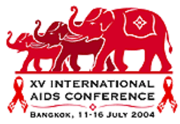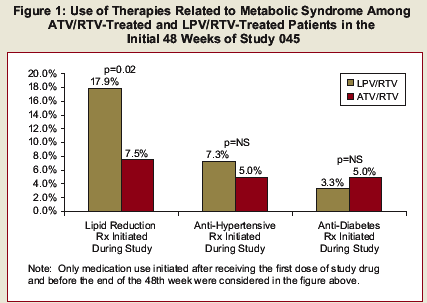 |
 |
 |
| |
Risk of Metabolic Syndrome (MetSyn) Among Highly Treatment-Experienced HIV-Infected Patients -- 48 Week Results from BMS Study AI424-045
|
| |
| |
|
|
| |
| |
 |
|
| |
| |
Reported by Jules Levin
Uchenna Iloeje, MD, MPH; Ying Wu, PhD; Paul Cislo, MS; Tom Kelleher, PhD; Linda Odeshoo, MS; Michael Giordano, MD
Pharmaceutical Research Institute, Bristol-Myers Squibb Company, Wallingford, CT
BMS presented this poster (5957) at the Bangkok IAC July 2004, which reports results of study looking at patients in Study 045.
Study 045 is a randomized open-label study of ATV 300 mg/RTV, ATV 400 mg/SQV and LPV/RTV each with a nucleoside backbone in highly experienced patients. This poster reports results from an analysis which compares Reyataz/r and Kaletra (LPV/r) with regards to the development of 'Metabolic Syndrome' in the study on study drugs, and the reversal of MetSyn after being randomized to 045 study regimens.
ABSTRACT
Background: MetSyn (Metabolic Syndrome) has been suggested as an independent cardiovascular (CVD) risk factor. Recent data suggest increased CVD risk among HIV-infected patients receiving protease inhibitors. Previous atazanavir (ATV) data suggest it does not adversely affect patient lipid levels, compared to other protease inhibitors. Since lipid abnormalities can increase the risk of MetSyn, we analyzed 48 week data of BMS AI424045 to evaluate incidence of MetSyn in ATV-treated patients compared to LPV/RTV-treated patients.
Methods: Week 48 data of study 045, a randomized open-label study of ATV 300mg/RTV, LPV/RTV, and ATV 400mg/SQV each with a nucleoside backbone in highly experienced patients, were analyzed. Adult HIV-infected patients, who had failed at least two regimens, including at least one PI-containing HAART, were enrolled.
A total of 243 subjects randomized to ATV/RTV (120) or LPV/RTV (123) were analyzed. NCEP (ATP-III) criteria were used to define MetSyn (abdominal obesity, high triglycerides, blood pressure, fasting glucose, and low HDL). Those who received diabetic, hypertension and hyperlipidemia treatment were considered as meeting respective criteria from that timepoint forward.Subjects who met 3 of 5 criteria were defined as MetSyn.
Results:
--At Week 48, there were 9 new cases of MetSyn on ATV/RTV arm.
--Fourteen of 31 MetSyn cases at baseline regressed (no longer met definition) at Week 48.
--On LPV/RTV, there were 16 new cases of MetSyn at Week 48. Ten cases of 31 at baseline regressed at Week 48.
--A logistic regression model adjusted for baseline MetSyn status suggested lower MetSyn risk for ATV/RTV-treated subjects (MetSyn: OR=0.52, 95%CI 0.27-1.01).
Conclusions: These data suggest a lower risk of MetSyn among ATV- treated patients when compared to LPV/RTV patients. MetSyn has been indicated as an important CVD risk factor. The association observed warrants further investigation.
STUDY METHODS
Adult HIV-infected patients, who had failed at least two regimens, including at least one PI-containing HAART, were enrolled in 045.
A total of 243 subjects randomized to ATV/RTV (120 subjects) or LPV/RTV (123 subjects) were analyzed. ATV/SQV was found to be less efficacious, compared to the other two treatment arms, and therefore those patients were excluded from this comparative analysis.
NCEP (ATP-III) criteria were used to define metabolic syndrome. Specifically, patient data on the following five parameters were evaluated:
-- abdominal obesity (waist circumference >102 cm in men; >88 cm in women)
-- high triglycerides (triglycerides >=150 mg/dL)
-- blood pressure (systolic >=130 mm Hg and/or diastolic >=85 mm Hg)
-- fasting glucose (>=110 mg/dL)
-- low HDL (<40 mg/dL in men; <50 mg/dL in women)
Subjects were assessed at baseline and at 48 weeks. Those who met at least 3 of the 5 criteria, as required in the NCEP guidelines, were defined as having metabolic syndrome.
To account for the effects of lipid lowering medication, anti-diabetic medication, and antihypertensive on the definition parameters, the following modifications to the NCEP criteria were made:
-- Patients who received therapy for diabetes were assumed to have elevated glucose from that time point forward.
-- Patients who received therapy for hypertension were assumed to have elevated blood pressure from that time point forward.
-- Patients who received therapy for hyperlipidemia were assumed to have elevated triglycerides and low HDL from that time point forward.
To verify that the groups were comparable at baseline, demographic characteristics were compared descriptively.
A last observation carried forward (LOCF) approach was used to impute missing postbaseline data.
The occurrence of metabolic syndrome at Week 48 was stratified by metabolic status at baseline and tabulated. A logistic regression model was constructed to test the association between study arm and metabolic syndrome at Week 48, while adjusting for baseline metabolic syndrome status.
The risk for meeting each criteria used to identify metabolic syndrome was also investigated with a logistic regression model, adjusted for baseline status (abnormal vs normal).
Post-hoc analyses of initiation of therapy for hyperlipidemia, hypertension, and diabetes were conducted.
Of those patients not being treated for the respective conditions at the start of the study, a fisher exact test was used to compare the two treatment arms based on the number of patients that initiated therapy during the trial.
RESULTS
A review of the demographic data indicates that the two treatment groups are comparable (Table 1).
Risk of developing metabolic syndrome was lower in ATV/RTV-treated patients.
--Thirty one patients in both arms met criteria for metabolic syndrome at study baseline
--14/31 (45.2%) in the ATV/RTV arm and 10/31 (32.3%) in the LPV/RTV arm regressed by week 48
-- Information on incident cases is contained in Table 2 below
A logistic regression model, which adjusted for baseline metabolic syndrome status, suggested lower risk for ATV/RTV-treated subjects (OR=0.52, 95%CI 0.27-1.01, p-value = 0.05).
Similar logistic regression models were developed to investigate each risk factor. The results indicated that ATV/RTV-treated subjects experience a significant reduction in risk for elevated triglycerides (OR=0.26, 95%CI 0.14-0.50, p-value <0.01). The differences observed for the other 4 risk factors were not significant and showed no trends (each p-value >0.50).
Therapy for diabetes and hypertension was initiated during the trial, however, the increased use was similar between ATV/RTV and LPV/RTV (Figure 1).
Lipid lowering therapy was initiated during the trial in both arms. Proportionally fewer ATV/RTV patients required therapy (Figure 1).
Table 1. PATIENT DEMOGRAPHICS
| ATV/r | LPV/r | | Age | 41 | 40 | | Region | | | | --N america | 33% | 38% | | --S america | 47% | 44% | | --Europe | 21% | 18% | | Gender(M) | 80% | 78% | | Race | | | | W | 63% | 58% | | B | 15% | 17% | | H | 23% | 22% | | Other | 0% | 3% | | AIDS | 28% | 29% | | IV Drug Use | 7% | 7% |
Table 2. NEW CASES of METABOLIC SYNDROME AT WEEK 48
| | ATV/r | LPV/r | | | N=84 | n=80 | | MetSyn | yes | 9 (10.7%) | 16 (20%) | | No | 75 (89.3%) | 64 (80%) |
Figure 1 shows 17.9% using LPV/r and 7.5% receiving ATV/r (p=0.02) initiated lipid reduction treatment during the 045 study. Use of anti-hypertensive treated initiated during study: 7.3% for LPV/r and 5.0% for ATV/r (p=ns). Anti-diabetes treatment initiated during the study: 3.3% for LPV/r and 5.0% for ATV/r.
|
|
| |
| |
 |
|
| |
| |
AUTHOR'S CONCLUSIONS
Established side effects of antiviral therapy, including dyslipidemia and insulin resistance, have lead to concerns of increasing CVD risk among HIV-infected patients on certain HAART regimens. Data from the recent DAD study demonstrated an increasing MI risk among HIV patients with increasing exposure to antiretroviral therapy.
Metabolic syndrome as an independent risk factor for CVD has been associated with a three-fold higher risk of adverse CVD outcomes in the non-HIV infected population.
This analysis applied a modification of the NCEP criteria to accommodate use of medications in defining the metabolic syndrome. Despite the small sample size, these results from a randomized clinical trial are noteworthy.
There are no precise estimates of the prevalence of metabolic syndrome in HIV-infected patients, but using a different set of criteria than used in this analysis, Bruno et al reported a prevalence rate of about 40% in a population of 201 HIV-infected patients.
These data suggest a 50% lower risk of developing metabolic syndrome among ATV/RTV- treated patients compared to LPV/RTV-treated patients during the first 48 weeks of the trial.
The development of hypertriglyceridemia appears to be the main driver of the metabolic syndrome incidence in this analysis.
|
| |
|
 |
 |
|
|